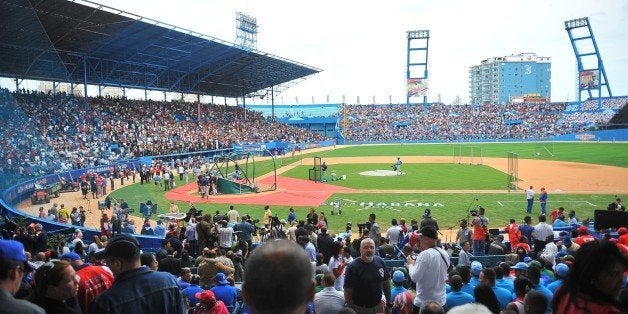
On December 17, 2014, like many others I was glued to the television, hanging on to every word of the announcement that President Obama was seeking to reestablish relations with Cuba after over 50 years. I could personally relate to this groundbreaking policy because 10 days earlier, I was an American playing baseball in Cuba.
In the fall of 2014, I had the opportunity to spend a semester studying at the University of Havana, living in the Vedado neighborhood of the capital, playing competitive baseball in the Cuban system. My experience predated any hint of warming of relations, and my story is one of being wholeheartedly accepted by "el pueblo Cubano", the Cuban people, who like me, share a deep passion for baseball.
I spent my first few weeks in Cuba searching all over Havana for my shot at Cuban baseball. As a 6'1" Irish American with reddish hair going from field to field looking to play ball, I can only imagine what the Cuban players thought. Finding pick-up games in Cuba was easy, but I was looking for a more organized, competitive game where I could train and play on a daily basis. As I proceeded to move up the rungs, Cubans would suggest I go see the same person: Lázaro de la Torre. Finally, a Cuban friend of mine said he knew where Lázaro's field was, and he was willing to take me to meet the man, to see if I could get a tryout for his team.
When I arrived at the field, my first thought was: "what in the world am I doing here?" The field's name and location said it all: "estadio cincuenta años", a field celebrating the 50-year anniversary of the revolution in 1959. The field was located right in the Plaza de la Revolución, directly across the street from the interior ministry.
With my Cuban friend making the introduction, we approached Lázaro, a gruff, imposing 6-foot-4-inch tall man with rough hands in a blue dirtied jumpsuit. For the field, Lázaro was the baseball trainer, coach, equipment manager, groundskeeper and mentor. Anything you could possibly think of, Lázaro did it. What I didn't know was that Lázaro was a national figure in Cuba. He is Cuba's Pedro Martinez, and pitching well into his late forties on the Cuban National Team, Lázaro would receive the name "Brazo de Hierro" or "Iron Arm."
My first impression of Lázaro only seemed to confirm my doubts of any success. I shook his hand and my Cuban friend did most of the talking, explaining that I was a student looking to play baseball. Lázaro had heard enough. He whistled for one of his catchers, handed me a baseball and told me to get loose. I warmed up, toed the rubber and fired in seven pitches as hard as I could. All of a sudden after the seventh pitch, he told me to stop. I asked, "Todo bien -- Is everything okay?"
He walked away without a word, so I packed up my bag, thinking it was another dead end. As I was taking off my cleats, he came over and looked me in the eyes for what seemed like the longest and most nerve-racking fifteen seconds of my life. He broke his silence and told me to come back tomorrow at 9 a.m.
For four months, I would return every day at 9 a.m., an American before normalized relations between our two countries, training and playing baseball in the center of Cuba's capital.
I never asked Lázaro why he was willing to take me on, but I didn't need to. The Cuban and the United States' governments have had an icy relationship for almost six decades, and at times, walking to the baseball field right next to the interior ministry building often reminded me of that broken relationship. But not once did I step on that field and feel like I wasn't a part of the team. Our similarities outweighed our differences.
As President Obama becomes first sitting U.S. president to visit Cuba since Calvin Coolidge in 1928, Cuba-U.S. relations have turned a new page. The most engaging, yet least controversial event on President Obama's schedule is his visit to Estadio Latinoamerica. Along side Cuban President Raúl Castro, he's attending the exhibition game played between the Tampa Bay Rays and the Cuban National Team.
At such an important time in our two countries' histories, baseball must play an integral role in bringing our two countries closer together. The game played between the Rays and the Cuban National Team is a substantial step for baseball, but an even bigger step for our countries. I can report firsthand that our shared love for baseball transcends politics, and it is an indestructible bridge that forever connects me to Cuba.
Matt is a Senior at Bates College in Lewiston, Maine, from Alexandria, Virginia